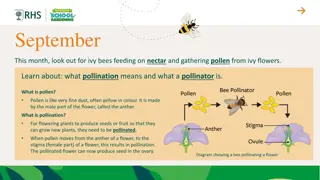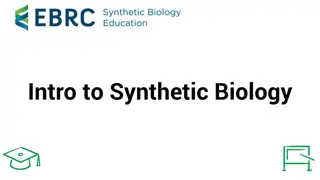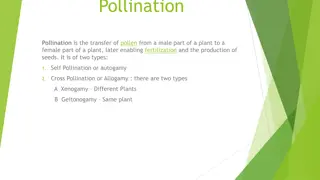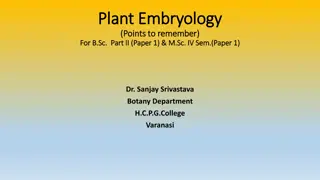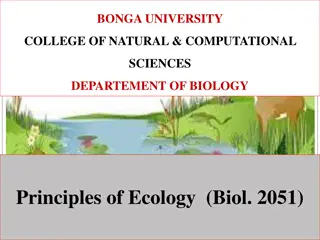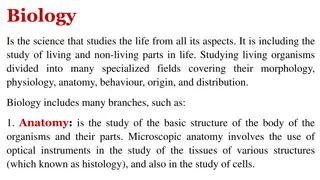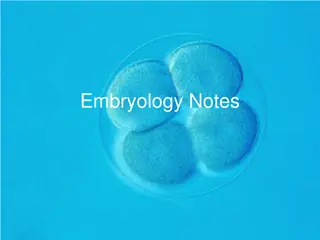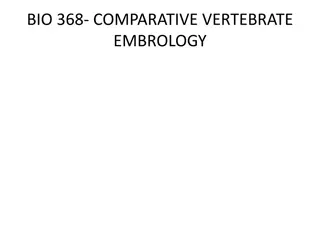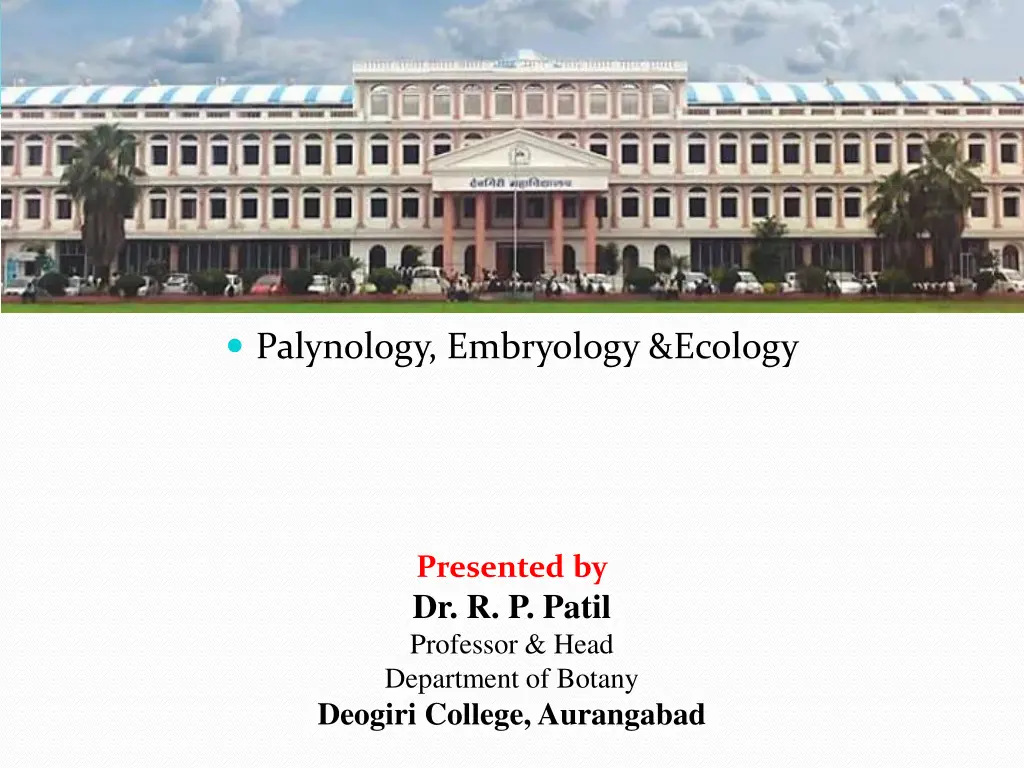
Palynology, Embryology & Ecology: Insights into Pollen Attributes in Taxonomy
Discover the science of palynology exploring pollen attributes in taxonomy, with a focus on families of dicotyledons and their significance. Learn about basic evidentiary characters of pollen, including unit type, polarity, shape, symmetry, and more. Explore the diverse characteristics of pollen grains and their classification based on aperture features. Gain insights into the unique structural traits of pollen grains and their importance in phylogeny, exemplified through various plant families.
Download Presentation

Please find below an Image/Link to download the presentation.
The content on the website is provided AS IS for your information and personal use only. It may not be sold, licensed, or shared on other websites without obtaining consent from the author. If you encounter any issues during the download, it is possible that the publisher has removed the file from their server.
You are allowed to download the files provided on this website for personal or commercial use, subject to the condition that they are used lawfully. All files are the property of their respective owners.
The content on the website is provided AS IS for your information and personal use only. It may not be sold, licensed, or shared on other websites without obtaining consent from the author.
E N D
Presentation Transcript
Palynology, Embryology &Ecology Presented by Dr. R. P. Patil Professor & Head Department of Botany Deogiri College, Aurangabad
Ravi Patil Deogiri College, Aurangabad
Polynology is the science of pollen and spores and its applications. It is derived from the Greek word palynein meaning to scatter. The significance of pollen attributes in taxonomy has been realised during the last three decades. The outer wall of pollen-grains is endowed with unique structural traits which are broadly categorised in order of their importance in phylogeny into the apertures, exine ornamentation, exine strata, shape and size. According to Bailey and Nast (1943), there are families of dicotyledons in which the pollen is of very considerable taxonomic significance not only in the differentiation of subfamilies and tribes but also of genera and species . A few examples will illustrate the statement. The Caryophyllales is recognised by centrospermous type of pollen with a spinuloseand punctate-perforate tectum. The Malvaceae and the Compositaecontain typically spinulose exine, the Plumbaginaceae verrucate pollen and the Gramineae smooth, sulcate ones.
Basic evidentiary characters: (i) Pollen unit type, (ii) Pollen grain polarity, (iii) Pollen grain shape, (iv) Pollen grain symmetry, (v) Pollen grains nuclear state, (vi) Pollen wall architecture, (vii) Exine stratification, (viii) Exine structure, (ix) Exine sculpture, (x) Aperture type, (xi) Aperture number, (xii) Aperture position, (xiii) Aperture shape, and (xiv) Aperture structure. In Magnoliidae the pollen is binucleate. In Caryophyllidae the pollen is trinucleate. In Ericaceae the pollen is in tetrads. In Asclepiadaceae pollen remain in Pollinia. In Taraxaccurn the pollen wall is echinate. In Quercus the pollen wall is scabrate.
Pollen grains may be simple (eumonad) or composite, e.g. dyad, tetrad, polyad, etc. They may be symmetrical, i.e., bilateral or radial, or asymmetric. The shape varies from spheroidal to oval, rhomboidal, rectangular in meridional view and circular to semi-angular, angular or lobate in polar view. They may further be distinguished as apolar, polar or heteropolar. The size of pollen grains varies from 8-10 m to 350 m in angiosperms. Palynological studies are based on the detailed and critical study of (a) Aperture- and (b) Sporoderm-morphology. Pollen grains may be without aperture, i.e., omniaperturate, or they may be mono-, di-, tri-, tetra- or panto-(poly) aperturate. Aperture serves as weak region for pollen tube emergence or harmomegatic function. Aperture may be simple-colpate or porate, or composite-colporate or pororate. They may be proximal (as in spores of Cryptogams), distal (as in pollens of Gymnosperms and Monocotyledons) or equatorial and global which are also called ana, cata, zono or panto. Simple apertures are present on the outer layer of sxine, viz., sexine or ektexine. Composite apertures are present both on external layer of exine, i.e., sexineor ektexine and also internal layer, i.e., nexine or endexine. The apertures may be long furrows or colpaor circular pores or ora. Pollen grains are classified and named variously on the number, position and character of apertures, e.g. trizono colpate, i.e., number of apertures three, position equatorial (zono) and character colpa-like, similarly pantocolpate, pantoporate, tetracolporate, and so on.
Sporoderm provides another important character for consideration. Sporoderm or pollen wall is made up of a very resistant substance called sporopollinin. It comprises of two layers, the outer is the ektexine (or sexine) and the inner is endexine (or nexine). The sporoderm encloses the intineand protoplasm. The spores of Pteridophytes have another external layer called penine. Both ektexineand endexinecomprise more than one layer which are detectable under microscope and more so by their staining behaviour. Ektexine presents various structural and sculptural elements which help in identification, classification, etc. Endexine does not present such structure and sculpture as the ektexine but its thickness or other irregularity help in various ways. Thus pollen morphology helps in solving many taxonomical problems at family, tribe, genus and even up to species level. It provides valuable information and together with other information gathered from other disciplines of botany brings a reasonable solution to many disputed questions in taxonomy.
NPC system: The pollen classification is based on number-position character analysis, called NPC system. As a rule, the number of apertures is only one in the cryptogams and gymnosperms whenever the grains are aperturate but the position is distal in the latter and proximal in the former and the apertures are non-trichotomous (e.g. monolete) or trichotomous (e.g. trilete) in character. The apertural conditions of pollen-grains have been looked upon as strong characters in solving taxonomic problems. It has been recommended that taxawith the same general NPC formula be grouped together and those showing aberrant NPC separately. For example, the Parietales of Engler-Diels has been probed by means of palynological compass needle . The NPC formula for the order is 345, i.e. pollen-grains are 3- termate (N3), zonotreme (P4) and colporate (C5). A significant variant is the Canellaceaewhere the pollen has one distal colpus; here NPC is 133, hence Hutchinson (1959) proposed shifting of Canellaceae from Parietales.
Apertual conditions: A general analysis of the apertural conditions in the plant kingdom reveals that apertures are ill-developed (primorphous) in thallophytes. In the archegoniates (comprising bryophytes, pteridophytesand gymnosperms), pollen-grains are trimorphousand in the angiosperms polymorphous. The above morphological situation provided a logical base for classifying the plant kingdom into the Primorphosporatae (Syn. Thallophyta), Trimorphosporatae (Syn. Archegoniatae) and Polymorphosporatae (Syn. Angiospermae) by Nair (1974). This analysis has thrown light on the phylogeny and evolution of the primitive angiosperms.
Embryology Embryology is the study of the successive stages of sporognesis, gametogenesisand the growth and development of embryo. Development and structure of the ovule; Origin and extent of the sporogenous tissue in the ovule; Megasporogenesis and development of the embryosac; Form and organisation of the mature embryosac; Fertilisation; Endosperm; Embryo and Seed-coat.
Embryology is the study of the successive stages of sporognesis, gametogenesis and the growth and development of embryo.
Anther loculi number, arrangement, (ii) Anther wall formation and endothecium type, (iii) Archesporial cell number, (iv) Aril presence, (v) Embryo sac development type, (vi) Embryo and Embryogeny type, (vii) Endosperm type, (viii) Integument number and structural type, (ix) Ovule orientation type and position, (x) Tapetal type, (xi) Perisperm presence, (xii) Nucellus character, and (xiii) Haustorium formation type. Embryological evidences are important at higher category level e.g., in conjunction with other types of evidences in confirming the systematic position of taxa. In Asteridae the ovules are unitegmic and tenuinucellate, in Caryophyllidae the ovules are bitegmic and crassinucellate. The embryo is embedded in Cyperales. In Cyperaceae only one microspore per microspore mother cell is formed. Only one of the four microspore develops into pollen grain while other 3 degenerate as in case of normal magaspore mother cell. In Graminales, the embryo is peripheral to endosperm.
Deviations from the Polygonum type of megagametophyte development are based on the following morphological criteria: The number of megaspores or megaspore nuclei that participate in the formation of the embryo sac. The total number of divisions that take place during the formation of the megaspore and gametophyte. The number and arrangement of the nuclei and their ploidy level in the mature embryo sac. Based on the number of megaspores, embryo sacs can be divided into three types: monosporic, bisporic, and tetrasporic (Web Figure 21.3.A). In the monosporic, or Polygonum-type embryo sac, meiosis of the diploid megaspore mother cell in the nucellus produces four haploid megaspores. Three of the megaspores, usually those at the micropylar end of the nucellus, subsequently undergo programmed cell death, leaving only one functional megaspore. In bisporic embryo sacs, meiosis produces only two megaspores, each containing two haploid nuclei, due to the absence of cytokinesis and cell plate formation following the second meiotic division. The megaspore nearest the micropyle then undergoes programmed cell death, leaving a single functional megaspore with two haploid nuclei. In tetrasporic embryo sacs, cell plates fail to form after both meiotic divisions, resulting in a single four-nucleate megaspore. All three patterns give rise to a single functional megaspore that contains either one (monosporic), two (bisporic), or four (tetrasporic) haploid nuclei. Note that the nuclei of the bisporic and tetrasporic embryo sacs are not genetically identical as they are in monosporic embryo sacs, because they arise from two or four different meiotic products.
Prof. Maheshwari (1964) reported Triradiate pollen grains in Loranthoidae and Polygonum type embryosac and spherical pollen grains and Allium type embryosac in Viscoideae. He was of the opinion that the two subfamihes be raised to family status as Lorantheceae and Viscaceae. It was approved by Takhtajan (1980, 1997), Dahlgren (1980), Cronquist (1981, 88) and Thorne (1981, 92).
Cytology in Relation to Taxonomy Cytology is the study of the morphology and physiology of cells. Normally anatomists deal with shapes, size, wall structure, pattern, etc. but cytologists deal with the internal organelles of the cell and detailed structure of cell wall. Some evidential characters are: (i) Chromosome number, structure, type, (ii) Chromosome meiotic behaviour, (iii) Ploidy level and type, and (iv) Chromosome aberration etc. Cytological evidences is used for distinguishing taxa; to determine the origin of groups and to understand the evolutionary history of related taxa particularly those at the infraspecific and specific levels cytotaxonomy is a part of experimental taxonomy. Such studies are helpful in determining the categories of genus, species etc. generally in cases of controversy. The study of homologies of the chromosome in the hybrids as determined in meiosis, is significant indicator in knowing the degree of genetic relationship.
The gametophytic chromosome number of diploid species is designated as base number (x). In diploids n = x, in polyploids n is multiple of x. e.g., in hexaploid sp 2n = 6x and n = 3x as 2n = 24 and n = 21. Angiosperm, the chromosome number varies greatly e.g., n = 2 in Haplopappus gracilis (Asteraceae) and highest is n = 132 in Poa litloroa (Poaceae). According to Raven (1975) the original base number for angiosperm is x = 7. In Ranunculaceae, it is generally x = 8. Thallictrum and Aquilegia have x = 7. They have been placed in separate tribes. Hutchinson placed them in two families Ranunculaceae and Helleboraceae based bearing and follicle bearing fruits. Paeonia with x = 5 is placed in Paeoniaceae. According to Radford (1988) n = 8 in Delphinium ajacis and n = 16 in D. carolinianum.
Chromosome number: The haploid number of chromosomes in angiosperms ranges from n = 12 in Halopappus gracilis (Asteraceae) to around n = 132 in Poa littoroa (Poaceae). Most of the angiosperms have chromosome numbers ranging between n = 7 and n = 12. About 35 to 40% per cent of the flowering plants are polyploids. In Morus nigra has the highest chromosome number (2n = 308), in M. cathyana there are forms with 2n = 56, 84; 112. Solanum nigrum is a good example of the existence of a species complex, comprising diploid (n = 12), tetraploid (n = 24) and hexaploid (n = 36) forms. Ophioglossum chromosome no is 1264
Chromosome morphology: A study of chromosome morphology is informative to the taxonomist in assessing affinities and modes of origin of separate species. The important work of Babcock in Crepis show how chromosome morphology coupled with chromosome number is of considerable importance in the genetic and taxonomic phases of study. V, L,J and i Chromosome size: It has already been discovered that evolutionary development involves in addition to alterations in chromosome number, their size, changes in structure etc., so that analysis of these cytological characters may also shed important light on species relationships. Recent observations on the Menispermaceae have shown that this aspect of cytology is sometimes valuable in taxonomic discussions.
Chromosome behaviour in crosses: The behaviour of chromosomes in crosses is a reliable factor in assessing relationships. Pathak (1940) made a careful karyotypic analysis of various species of Aegilops, Secale and Triticum, suggesting that the hexaploid T. spelta and T. vulgare were probably derived through hybridisation between a tetraploid wheat and Roy (1959) carried out detailed genome analysis of Aegilops longissima and A. sharonensis. On the basis of chromosome pairing and fertility of F1 hybrids and the derived amphidiploidy, he thought that the two species are closely related. From a study of the karyotypes of species of Aegilops, Cheenaveeraiah (1962) postulated that the section Sitopsis should be shifted from Aegilops to Triticum or given the rank of a new genus.
Chromosomal aberrations may be seen in meiosis. This may cause variation in population. The value of chromosomes as markers depends on the fact that they give rise to others of their kind in a highly specific manner. Plant nuclear chromosome has localized centromere. If there is a loss of localized centromere due to aberration, it develops into an eccentric chromosome, unable to move in spindle and is eliminated.
Ecology in Relation to Taxonomy: The ecological criteria are of comparatively little direct importance in taxonomy, though ecological criteria at the interspecific level can not be neglected. In flowering plants, tolerance and plasticity are widespread. The tolerance of a plant population is determined by its ability to survive and reproduce upon exposure to a range of environmental factors. The tolerance is greater when the range is wider. On the other hand, plasticity is ascertained by the degree to which the appearance of plants vary in moving from one set of factors to the other. Ecological studies can help in determining the taxonomic status of a species. On the basis of developmental morphology, culture experiments and other analytical data, the two species of Lindenbergia, L. polyantha and L. urticaefolia, have been demonstrated to be ecotypes of the same species, the former being a calcicolous or a miniature form of the latter.




